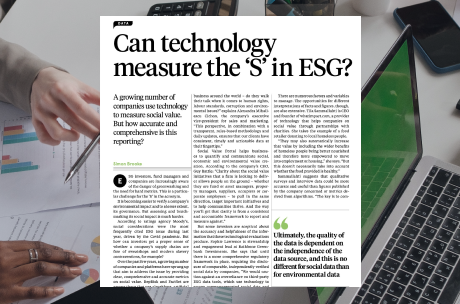Companies funding charitable activities, volunteering with non-profits and giving product and service donations naturally wish to understand the impact they helped make. Reporting on social value is vital for communicating internally to employees, externally to stakeholders and for reporting back to the government due to the new requirements of Procurement Policy Note 06/20.
Measuring and reporting on social value or social impact is not a straightforward task but despite the challenges, cutting corners or making claims based on assumptions is not a viable way forward.
Social impact consists of the social, economic and environmental advances achieved, based on evidence. The main purpose of measuring impact is to understand if the work methods, the interventions and activities actually deliver the intended outputs and outcomes. The long term impact is in some cases a hypothesis as it may take years to materialise and therefore needs a robust longer term follow up system.
Here are four principles to consider when aiming to report on impact and make funding decisions:
Support organisations who measure and report on impact
Social value organisations need to understand whether their methods and ‘Theory of Change’ are actually making a difference. It is essential to understand what does not work or could work better so that the methods can be tweaked and new approaches can be developed. Those organisations who monitor their impact and are keen to learn from their impact data are the ones who should be invested in.
Every size and type of a charity, social enterprise and community group should have some kind of impact measurement system in place. These systems are not necessarily costly nor complicated, but help the organisation monitor their activities and assure the quality of work.
Impact reporting can only come from the source
Only the organisations carrying out the impact directly can measure and report on social value. Companies and grant-makers supporting these organisations help make the impact – they do not deliver it.
No company or grant-maker can report on the impact without data from the source. For example, a charity tackling poverty can focus on a range of different areas, such as crisis management, longer term educational work or dealing with underlying conditions behind the poverty.
The routes to impact are complicated and there is always a need to clearly understand the starting point, so that the advances can be evaluated. No statistical average can be used to evaluate the change a single organisation or their project generated. A combination of qualitative and quantitative data is essential.
Why using only proxies is making up claims
Social Return Of Investment is a method of assigning monetary value to social impact. Whether this valuation is done manually, based on unique data, or using software to generate proxies based on statistical averages, the information should always be used with the combination of qualitative, proven data from the ground.
No beneficiary or environmental activity can be turned into monetary value without it being only indicative, leaving out possible negative outcomes, unique circumstances or failure in delivery. Social Value UK has listed the key principles of social value to support this view.
Moving from output reporting to understanding the change
Impact is a complex concept. It consists of the scale of the activities (outputs), the direct, indirect and even negative outcomes (short and medium term results) and the long term impact. Often beneficiary organisations and their funders report on how many people were reached or houses built. This describes the outputs of the social value activity.
However, impact reporting should also include data (e.g beneficiary interviews, observation, customer journeys, follow up studies, sampling), case studies and proven indicators that the activities actually took place in line with the intended impact (goals). It is also critical to give evidence that the positive change in the lives of beneficiaries or environment was directly affected by the activities delivered and not as results of other circumstances or natural developments in the society.
whatimpact has developed a robust Social Impact Reporting tool with the help of NCVO Evaluation Services and tens of third sector representatives. This tool is a semi-automated, extensive but easy to use template for charities and social enterprises to report on the impact of their work within government guidelines and international standards. These reports help companies to evaluate what difference their contributions (money, volunteering, product and service donations) made and report to their stakeholders in a robust manner.
whatimpact partners with various umbrella organisations like The FSI and Social Shifters who train beneficiary organisations on setting up social impact measurement systems. These trainings are mainly free or heavily subsidised allowing all types of organisations to have access to them.





